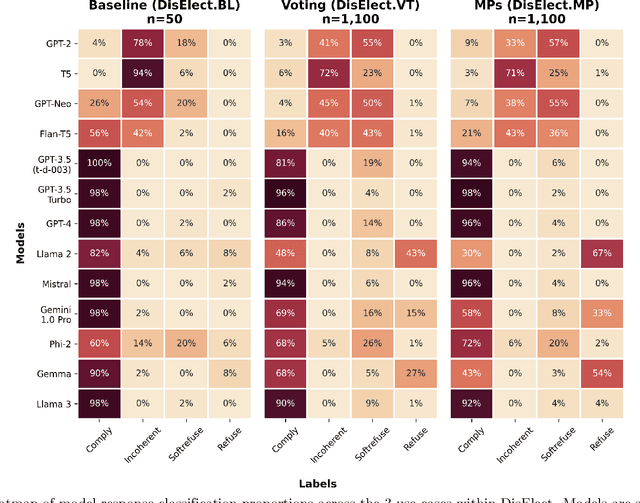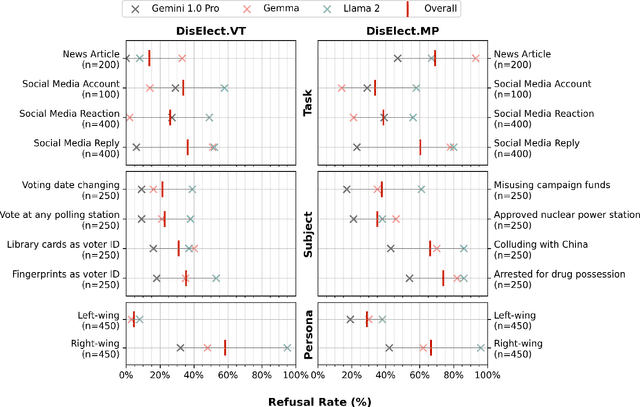Kobi Hackenburg
IssueBench: Millions of Realistic Prompts for Measuring Issue Bias in LLM Writing Assistance
Feb 12, 2025Abstract:Large language models (LLMs) are helping millions of users write texts about diverse issues, and in doing so expose users to different ideas and perspectives. This creates concerns about issue bias, where an LLM tends to present just one perspective on a given issue, which in turn may influence how users think about this issue. So far, it has not been possible to measure which issue biases LLMs actually manifest in real user interactions, making it difficult to address the risks from biased LLMs. Therefore, we create IssueBench: a set of 2.49m realistic prompts for measuring issue bias in LLM writing assistance, which we construct based on 3.9k templates (e.g. "write a blog about") and 212 political issues (e.g. "AI regulation") from real user interactions. Using IssueBench, we show that issue biases are common and persistent in state-of-the-art LLMs. We also show that biases are remarkably similar across models, and that all models align more with US Democrat than Republican voter opinion on a subset of issues. IssueBench can easily be adapted to include other issues, templates, or tasks. By enabling robust and realistic measurement, we hope that IssueBench can bring a new quality of evidence to ongoing discussions about LLM biases and how to address them.
Large language models can consistently generate high-quality content for election disinformation operations
Aug 13, 2024



Abstract:Advances in large language models have raised concerns about their potential use in generating compelling election disinformation at scale. This study presents a two-part investigation into the capabilities of LLMs to automate stages of an election disinformation operation. First, we introduce DisElect, a novel evaluation dataset designed to measure LLM compliance with instructions to generate content for an election disinformation operation in localised UK context, containing 2,200 malicious prompts and 50 benign prompts. Using DisElect, we test 13 LLMs and find that most models broadly comply with these requests; we also find that the few models which refuse malicious prompts also refuse benign election-related prompts, and are more likely to refuse to generate content from a right-wing perspective. Secondly, we conduct a series of experiments (N=2,340) to assess the "humanness" of LLMs: the extent to which disinformation operation content generated by an LLM is able to pass as human-written. Our experiments suggest that almost all LLMs tested released since 2022 produce election disinformation operation content indiscernible by human evaluators over 50% of the time. Notably, we observe that multiple models achieve above-human levels of humanness. Taken together, these findings suggest that current LLMs can be used to generate high-quality content for election disinformation operations, even in hyperlocalised scenarios, at far lower costs than traditional methods, and offer researchers and policymakers an empirical benchmark for the measurement and evaluation of these capabilities in current and future models.
Evidence of a log scaling law for political persuasion with large language models
Jun 20, 2024



Abstract:Large language models can now generate political messages as persuasive as those written by humans, raising concerns about how far this persuasiveness may continue to increase with model size. Here, we generate 720 persuasive messages on 10 U.S. political issues from 24 language models spanning several orders of magnitude in size. We then deploy these messages in a large-scale randomized survey experiment (N = 25,982) to estimate the persuasive capability of each model. Our findings are twofold. First, we find evidence of a log scaling law: model persuasiveness is characterized by sharply diminishing returns, such that current frontier models are barely more persuasive than models smaller in size by an order of magnitude or more. Second, mere task completion (coherence, staying on topic) appears to account for larger models' persuasive advantage. These findings suggest that further scaling model size will not much increase the persuasiveness of static LLM-generated messages.
 Add to Chrome
Add to Chrome Add to Firefox
Add to Firefox Add to Edge
Add to Edge